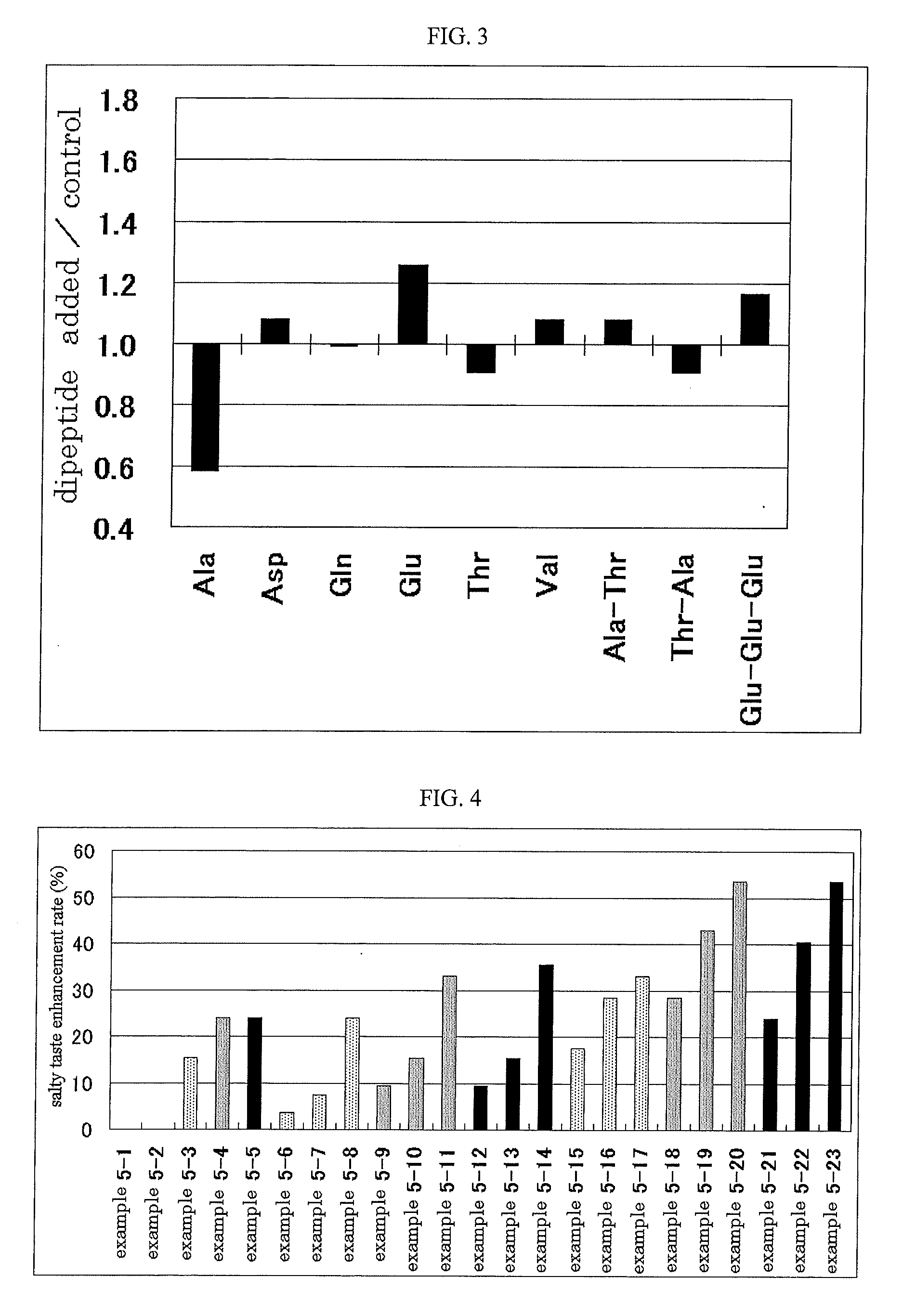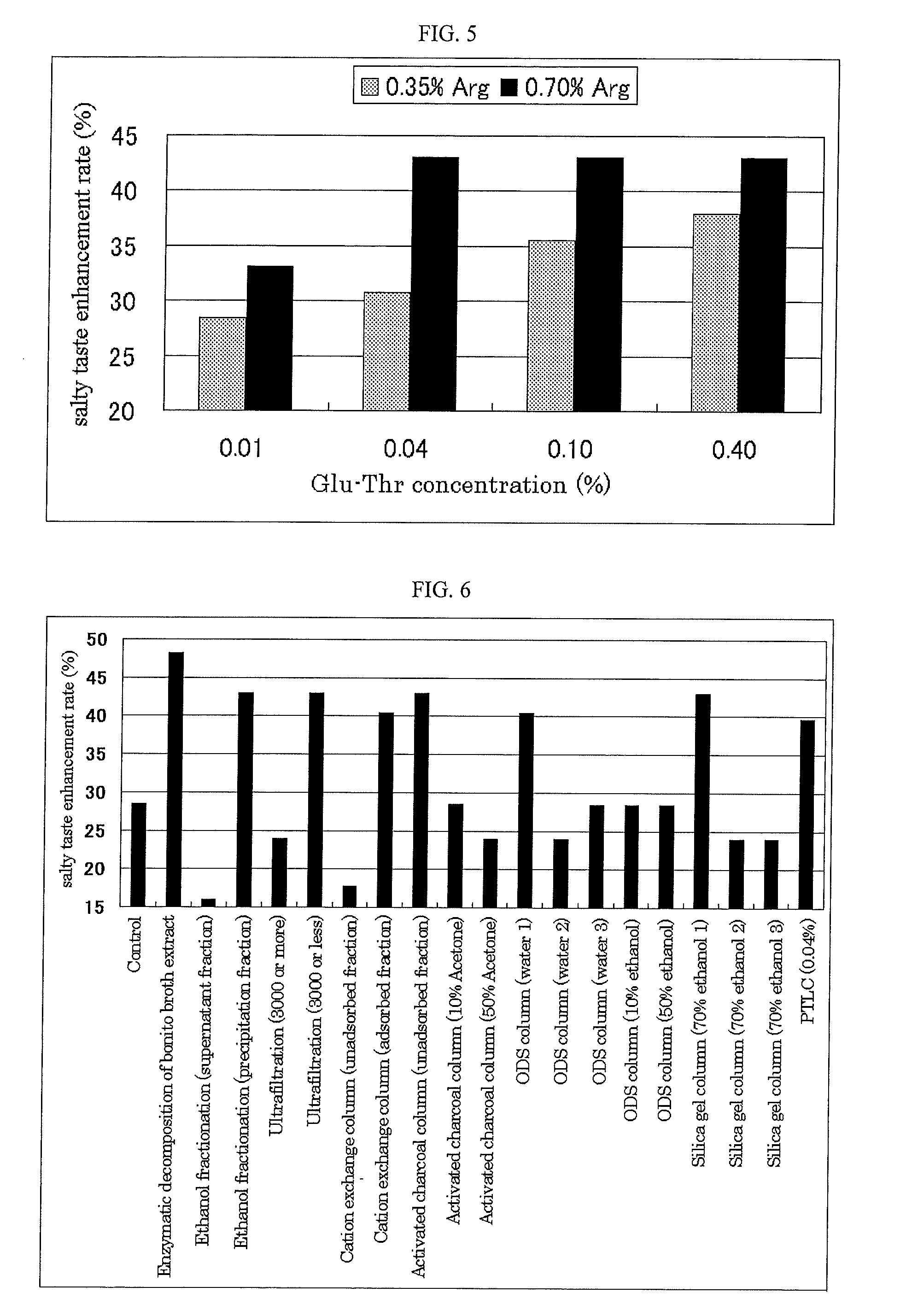Salty taste enhancer and food or drink containing the same
a technology of enhancer and salty taste, which is applied in the field of salty taste enhancer, can solve the problems of increasing the risk of conditions such as hypertension, kidney disease and heart disease, food and drink simply having reduced quantities of common salt losing flavor and becoming bland, and salty taste alternatives have the drawback of imparting bitter, peculiar, or unpleasant taste in addition to salty taste. , to achieve the effect of enhancing the salty taste and reducing the quantity of common salt used
- Summary
- Abstract
- Description
- Claims
- Application Information
AI Technical Summary
Benefits of technology
Problems solved by technology
Method used
Image
Examples
working example 1
Methods of Analysis
1. Measurement of Common Salt Content
Common salt content was measured according to the following method. A sample was diluted 25 times in 1% HCl and shaken for 30 minutes to extract sodium ions, the extracted sample was diluted in an arbitrary quantity of 1% HCl, and sodium content was measured using an atomic absorption photometer (Z-2000, manufactured by Hitachi High Technologies). The common salt content was calculated by multiplying the obtained sodium content by 2.54.
2. Measurement of Active Ingredient Content
The active ingredient content of the salty taste enhancer of the present invention was determined by subtracting the common salt content from the Brix value of the products. Moreover, the Brix value was measured using a Brix meter (PAL-1, manufactured by Atago Co., Ltd.).
3. Measurement of Salty Taste Enhancement Effect (Salty Taste Enhancement Rate)
The salty taste strength of a sample solution adjusted so that the common salt concentration was 0.49% (w / w...
working example 2
Amino Acids, Dipeptides, Tripeptides
Amino acids, dipeptides and tripeptides having purities of 98% or higher were purchased from Wako Pure Chemical Industries, Ltd., BACHEM or AnyGen and used in the tests.
working example 3
Production of Enzymatic Decomposition Products Using a Variety of Protein Materials as Raw Materials
1. Production of Enzymatic Decomposition Product of Wheat Gluten
Wheat gluten: 29.7 g of A-Glu-G (produced by Glico Foods Co., Ltd.) was made up to 200 g through dispersion in 0.6N HCl. This dispersion was treated for 120 minutes at 120° C. in an autoclave and, following the treatment, the reaction liquid was adjusted to a pH of 8.0 by means of 2N NaOH while checking the pH with a pH meter (F-50, manufactured by Horiba, Ltd.) and made up to 200 g with water. 1 g of Alcalase 2.4 L (produced by Novozymes) was added to the liquid and allowed to react for 6 hours in a water bath at 55° C. Following the reaction, the enzyme was deactivated by heating for 30 minutes at 95° C., and an enzymatic decomposition product of wheat gluten was obtained by subjecting the reaction liquid to centrifugal separation for 15 minutes at 7000 rpm (using a 50A-IV centrifugal separator manufactured by Sakuma) a...
PUM
| Property | Measurement | Unit |
|---|---|---|
| Fraction | aaaaa | aaaaa |
| Fraction | aaaaa | aaaaa |
| Fraction | aaaaa | aaaaa |
Abstract
Description
Claims
Application Information
 Login to View More
Login to View More - R&D
- Intellectual Property
- Life Sciences
- Materials
- Tech Scout
- Unparalleled Data Quality
- Higher Quality Content
- 60% Fewer Hallucinations
Browse by: Latest US Patents, China's latest patents, Technical Efficacy Thesaurus, Application Domain, Technology Topic, Popular Technical Reports.
© 2025 PatSnap. All rights reserved.Legal|Privacy policy|Modern Slavery Act Transparency Statement|Sitemap|About US| Contact US: help@patsnap.com



